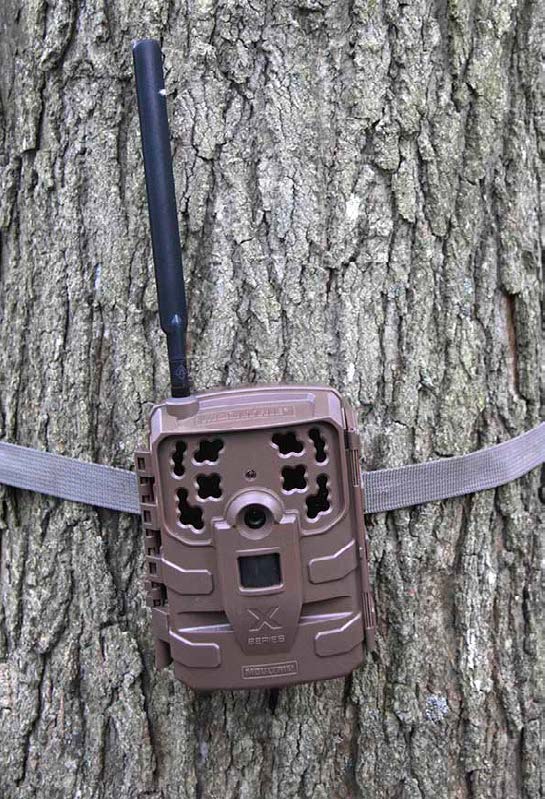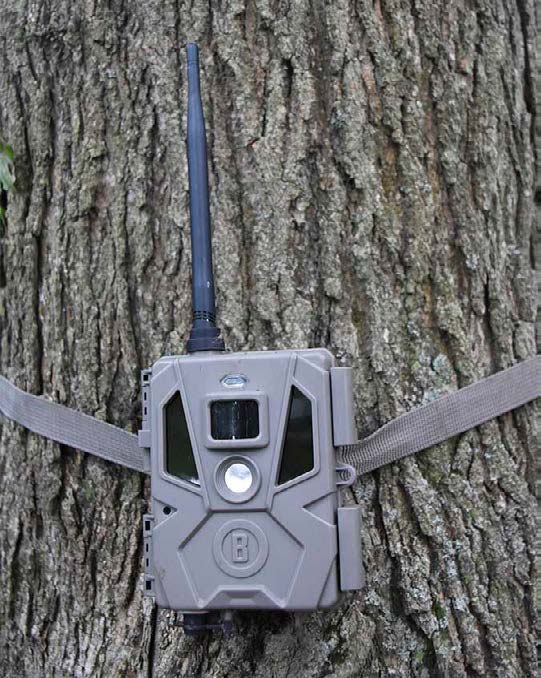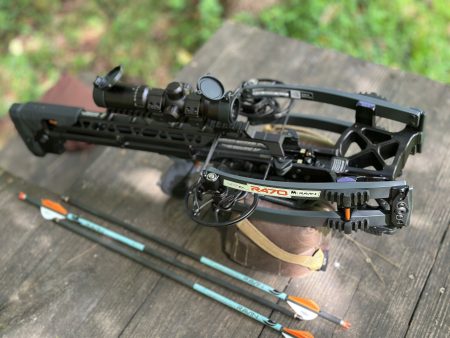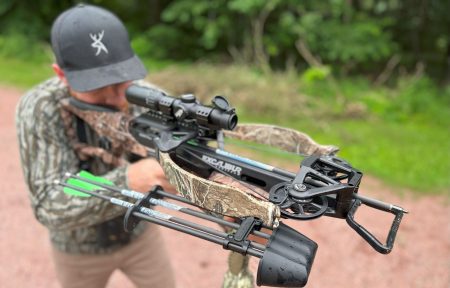Introduction
The cellular trail camera has revolutionized remote scouting, allowing hunters to monitor wildlife activity from their smartphones. No longer bound by constant trips to check cameras, users can scout efficiently without disturbing their hunting areas. In this comprehensive review, we tested and compared the top cellular trail cameras from leading brands like Spypoint, Bushnell, Moultrie, and Stealth Cam. From photo quality to app usability, we break down each camera’s performance to help you choose the perfect trail camera for your scouting needs in 2024. Dive in to see which models stood out as the best for your next adventure.
Share
When trail cameras were introduced a few decades ago they were touted as the ultimate tool for remote scouting. The more recent introduction of the cellular trail camera has upped the game, making it possible to scout from the comfort of your easy chair while disturbing the hunting area as little as possible. There are a wide variety of cellular trail camera companies on the market today. The makers of the best cellular trail cameras include: Bushnell, Moultrie, Spypoint and Stealth Cam. Each provided cameras for our review of their features and operations. In this review, we looked at several cellular trail camera options ranging from 2022 models to 2024 and selected the winners and ones we recommend.
We judged the cameras and broke down their construction, ease of use of the app, photo plans, and more; here’s what we found:
The list of winners is below for your convenience. Click the green to shop, and click the orange to see why it was selected.
- Best Overall Cellular Trail Camera (Non-Solar): Spypoint Flex M – (Click to Shop)
- Best Night Vision Trail Camera: Bushnell’s Cellucore– (Click to Shop)
- Best Overall Solar Cellular Trail Camera: Spypoint Flex S – (Click to Shop)
- Best Value Cellular Trail Camera: Spypoint Link Micro – (Click to Shop)
- Best Action Capture Cellular Trail Camera: Moultrie’s Delta Base – (Click to Shop)
- Best Connection: Stealth Cam Reactor – (Click To Shop)
Best Overall Cellular Trail Camera (Non-Solar): Spypoint Flex M
From a hunter’s perspective, the SPYPOINT FLEX M is the best cellular trail camera because it provides everything needed to maximize scouting efficiency without constant trips to check the camera. Its dual-sim card technology ensures it always connects to the strongest network in the area, meaning no missed photos or downtime, even in remote locations. The camera’s 33MP resolution delivers crystal-clear images, allowing hunters to confidently identify game patterns and size. Its fast trigger speed and accurate detection minimize false alarms, ensuring only relevant images are sent directly to a smartphone via the easy-to-use SPYPOINT app. This combination of high-quality performance, reliable connectivity, modest price point, and remote management with the app makes the FLEX M a game-changer, saving valuable time and energy while helping hunters stay one step ahead of their target.
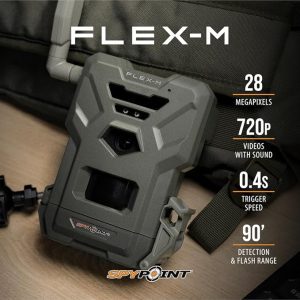
Construction:
The SPYPOINT FLEX M is designed with durability and adaptability in mind, making it an ideal choice for hunters and outdoor enthusiasts. Its rugged construction ensures it can withstand harsh environmental conditions, such as rain, dust, and extreme temperatures, while delivering reliable performance. The FLEX M features a robust, weather-resistant housing that protects its advanced cellular camera technology. This design allows for easy field use, with simple setup and configuration via the SPYPOINT app. Its compact size and versatile mounting options further enhance its usability, ensuring it can be securely placed in various locations without compromising its durability or effectiveness.
Ease of Use of the App:
The Spypoint app enhances the ease of use for all Spypoint Cellular Trail Cameras, offering an intuitive, user-friendly experience. Setting up the camera through the app is straightforward, allowing users to connect the device quickly to their mobile phones. The app simplifies photo and video management by sending real-time images directly to the user’s smartphone, eliminating the need to check the camera in the field.
Users can easily adjust camera settings, monitor battery life, and manage data plans remotely through the app and the Spypoint website. Features like customizable photo transmission frequency, firmware updates, and photo tagging are accessible with just a few taps. Additionally, the app’s interface is clean and responsive, making it simple to navigate and control the camera from anywhere with cellular coverage. It adds convenience for hunters or wildlife enthusiasts managing multiple cameras. New for this year is the ability to share camera photos and videos with other users by adding their email addresses to the account.
Photo Plans:
1. Free Plan
- Cost: $0 per month
- Photos: 100 photos per month
- Features: Basic access with limited photo transmissions.
2. Basic Plan
- Cost: Around $5 per month (pricing may vary)
- Photos: 250 photos per month
- Features: Great for moderate users, allowing more flexibility for image capture while maintaining cost efficiency.
3. Standard Plan
- Cost: Approximately $10 per month
- Photos: 1,000 photos per month
- Features: Ideal for more active users who want a larger data allowance without breaking the bank.
4. Premium Plan
- Cost: Around $15 per month
- Photos: Unlimited photos per month
- Features: Perfect for heavy users or those monitoring high-traffic areas, offering complete freedom with no photo limit.
Each plan also allows access to Spypoint’s Advanced AI Filters, which help sort images by species or activity. All users can access features like firmware updates and remote camera control through the app. Users can easily switch between plans or purchase additional photo/video bundles if they exceed their monthly limit. Discounts are available for multiple camera setups and participation in the Spypoint Insiders Club.
Best Overall Solar Cellular Trail Camera: Spypoint Flex S
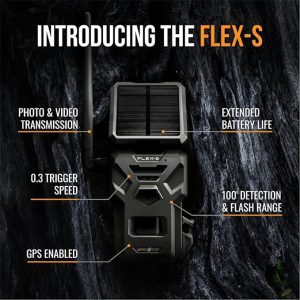
Side note: For our 2024 Rut Report Program, we chose this camera based on its ease of use and photo/video clarity. You can see all the images and videos in our Facebook content at www.facebook.com/NADeerHunter.
Construction:
The Spypoint Flex S Trail Camera is built with durability and field performance in mind. Its rugged, weather-resistant housing protects the internal components from harsh outdoor elements such as rain, snow, and extreme temperatures, ensuring long-term use in various environments. The compact design features a sturdy latch system that secures the camera door tightly, protecting the SD card slot, battery compartment, and SIM card from dust and moisture.
The integrated solar panel is seamlessly built into the body, reducing the need for external power sources, while the internal lithium battery adds to its robust, low-maintenance construction. The camera’s mounting system is user-friendly, allowing for secure placement on trees or other surfaces. Overall, the Spypoint Flex S is designed to withstand the demands of outdoor use while maintaining reliable functionality.
Ease of Use of the App:
Same as the Spypoint Flex M.
Photo Plans:
Same as the Flex M
Best Value Cellular Trail Camera: Spypoint’s Link Micro – Click to Shop
Construction:
Spypoint’s Link Micro series has simple controls. There is an on/off switch and one LED that signals the strength of the signal. These cameras take a micro-SD instead of the SD card used by the other cameras, and the Micro is the smallest of those tested. It has a lithium battery pack and solar panel in the S format but eight AAs in the non-solar format. The bottom two-thirds of the camera are closed by a solid latch.
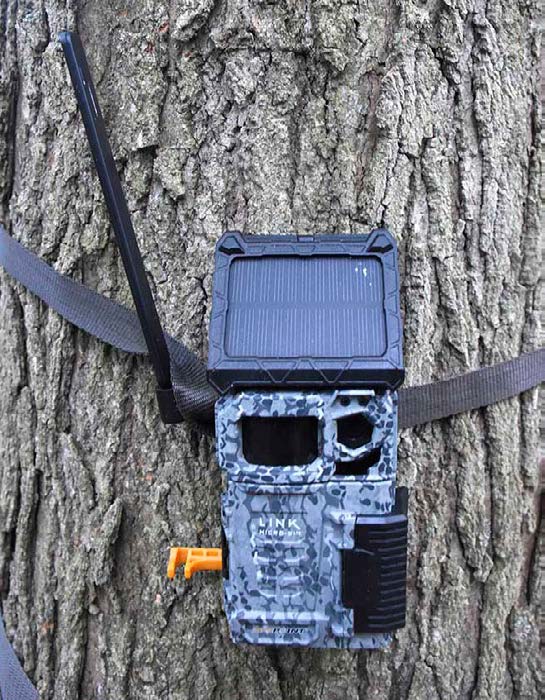
Ease of Use of the App:
Spypoint’s app is simple to operate and has species filters but none for weather-related data. It also has a map for locating the camera and a variety of controls for controlling the camera.
Photo Plans:
Spypoint’s plan is the only one with a free option. There is a free plan, which could be used during the off-season, and it provides up to 100 photos per month at no charge. Going to the Basic plan moves the photo count up to 250 for $5 per month. The Standard plan is for 1,000 photos and costs $10 per month. The unlimited plan is $15 per month. Subscribing annually reduces the costs by $1 to $5 per month.
Spypoint’s Flex series also uses a micro-SD, but it has more controls and unique transmission features that will be discussed later. It has LEDs for signal strength and battery power status. There is a button to format the card and a test button to take a photo, which is unique. The Flex takes eight AA batteries. Both Spypoint cameras have folding antennas.
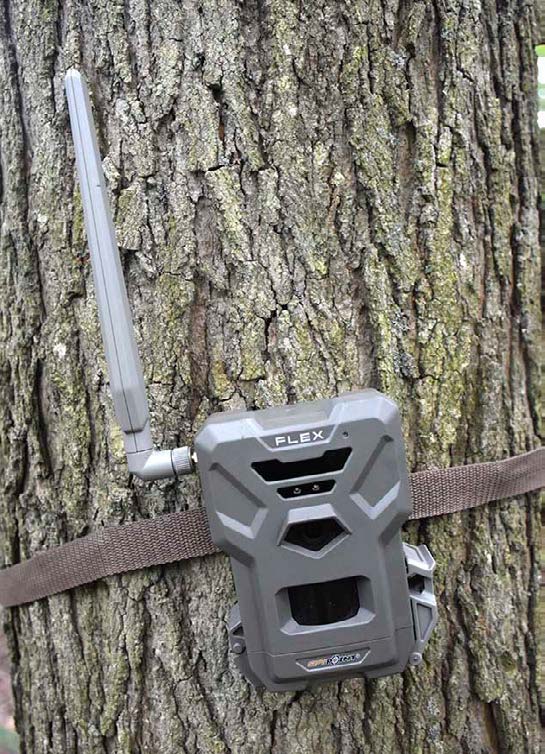
More to Note:
As noted, most apps offer filters to show photos of bucks or turkeys only. I didn’t have much luck with consistent results using the filters on any of the cameras, but I did get inconsistent success. All the apps froze or glitched occasionally, but they were easily fixed by simply closing and reopening the app.
With the cameras tested, image quality could be divided into two categories—those with traditional pixelated images and those with better image quality. The Spypoint Micro-S and Bushnell fell into the pixelated class, while the Stealth Cam, Spypoint Flex series, and Moultrie had better image quality. Even the pixelated images were good enough to judge a deer or turkey, though.
Best Action Capture Cellular Trail Camera: Moultrie’s Delta Base – Click to Shop
Construction:
The Moultrie Delta Base has a solid lock that goes the full length of this 12-battery camera and should be problem-free. It has appropriately placed holes for cables or locks. It takes four batteries and has switches for on/ off, format, and connect/status. These buttons and a series of four LEDs allow testing the signal and providing battery status. The antenna folds on this camera, which is handy when transporting it.
Ease of Use of the App:
Moultrie was the only camera where activating it was an issue. A call to customer service resolved the issue. The representative answered the phone quickly and fixed the problem. The app was easy to operate and had a lot of options, including order history and device manuals, that weren’t on the other cameras. Options for how the images were displayed (either single or time taken or uploaded) were available. Filters for the images also provided more options than other apps, including time of day, moon phase and temperature. Notifications also provided more options, including notifications for low batteries or data usage, and these could be received either by text or e-mail. Moultrie’s app did have a GPS map to locate the camera.
Photo Plans:
Moultrie’s price structure has two options for three different tiers. Standard, which is 1,000 images, is $9.99 per month and $8.99 if paid upfront for the year. For $16.99, you get unlimited images and 50 videos. Switching to the Pro Series Unlimited, there are options for sharing images and videos amongst multiple cameras.
Stealth Cam Reactor – Click To Shop
Construction:
The Stealth Cam Reactor has an on/off switch, a sync button, and an eject button for the battery compartment. The bottom third of the camera opens to access the control panel and the latch is solid. The antenna does not fold. LEDs indicate the camera status (battery strength and SD card present), signal strength, and if the account isn’t found. Eight batteries are used for power.
Ease of Use of the App:
The Stealth Cam Command Pro app isn’t as easy to operate but is still feature-packed. It doesn’t have as many choices of filters but does have three options for viewing different styles of viewing photos and a wide variety of species filters. It does have a map though.
Photo Plans:
Stealth Cam’s $5 option provides 600 photos per month and 300 videos. Those counts jump to 2,000 photos and 1,000 videos for $10 per month. For $20, you get unlimited counts, while $50 gives 36,000 photos and 18,000 videos, and it allows three cameras on the plan. Slightly reduced prices are available for annual rates. There is also a data limitation with Stealth Cam’s plan.
Best Night Vision: Bushnell’s Cellucore– Click to Shop
Construction:
The Bushnell Cellucore is also a 12-battery camera with the entire camera opening for access. LEDs display the camera status, battery life and cellular signal. A wake-up button will display the status if the camera was idle. Two solid locks close the camera. The antenna does not fold. It also has a solar option ($131.33) (slightly more expensive) for those who don’t want to spend time changing batteries or may have hunting land further from homebase.
Ease of Use of the App:
The Bushnell app is easy to operate. It features support and help with FAQs and instructional videos in the menu. It sends reminders when the camera hasn’t communicated with the phone in a few days, which is a great feature. Filters give a wide variety of choices, including barometric pressure and moon phases. There are also two choices for image viewing, one of which is larger. The app does not have a filter for species, though.
Photo Plans:
Bushnell’s basic plan costs $9.99 per month for 2,000 images but no videos. An additional $5 gets the user unlimited videos and images.
Transmission in Remote Areas
Finding a good cell signal is one of the challenges of placing trail cameras in the woods, and sometimes, vegetation further blocks the signal.
Most of these cameras are set up to pick up either of the cell networks (often referred to as AT&T or Verizon in the U.S) and that network only. Spypoint’sold technology will find the strongest signal on either network and then stick with that network until moved or turned off. With the Flex, the camera has the ability to look for the strongest signal on a constant basis and switch networks automatically. When I conducted my test, I turned all the cameras to instantaneous transmission, which means each photo should be uploaded as soon as it is taken. Alert tones were going off for the Spypoint Flex and Stealth Cam as soon as they were turned on.
The others followed as the cameras picked up a signal. In my experience, in areas with weak signals, the cameras will lose connection and reconnect. This is something I am sure everyone has experienced with their cell phone. so that’s not surprising. Over the next few days, I noticed that a similar pattern followed for photo transmission as the deer walked in front of the camera. It’s worth noting the Bushnell was the closest camera to the ground, which did put it at a disadvantage, and the new technology in the Flexdid helped. Over the testing period, there was some change in which the camera captured and transmitted photos first, with all of them taking the lead on different days.
One important takeaway is that although the cameras were on the same tree, there were times when one camera would pick up a deer and others would not. This situation also switched between cameras over the test period.
One important takeaway is that although the cameras were on the same tree, there were times when one camera would pick up a deer and others would not. This situation also switched between cameras over the test period.
Another thing that became obvious is that some cameras have a wider field of view than others. For those who often hunt in tight woods, this factor might be something to keep a look out for.
Although it wasn’t released when this article was written, the Moultrie Edge is also available to connect to multiple networks. It also has a built-in memory instead of a card. Also just released this fall, the Bushnell Cellucore 20 Solar has dual sim technology plus a solar panel and rechargeable batteries.
One option with some, but not all manufacturers, is auxiliary antennas. These devices allow the antenna to be strapped to the tree in a higher spot, which is an advantage in many situations. If you are putting up cameras in areas with poor cell coverage, you may want to ensure this option is available before buying a camera.
Action Photos
To test the ability to capture action, I set my English cocker spaniel Molly down outside the test area, walked across the test area, then called her to me. She has only one speed when doing this—full out. The only capture of Molly racing by was by the Bushnell. The Spypoint Micro-S did capture some running deer photos during the pre-test period.
Battery Life
In the interest of full disclosure, some of the test cameras arrived earlier than others, for reasons varying from new models coming out to logistics. I put the Stealthcam, Spypoint Micro-S and Bushnell to work for a month during turkey season, and then conducted the full test. All still showed full battery life with transmission set to instantaneous, which uses the most battery power, even after the full testing. Moultrie and Spypoint Flex were added for the testing only. The Flex did bring down the batteries some.
For a complete test of battery life, a longer time period is needed. Any battery test should also be completed in cooler hunting season, which is tougher on batteries. Bushnell claims six-month battery life, which if it is true, is a real advantage. So too is the Micro-S, with its rechargeable batteries and solar panel, and it is hassle- free in the battery department.

Other Observations
During the pre-test period, all three cameras captured a lot of deer and turkey photos. Then, for an unknown reason, the deer didn’t seem to appear as often. The change could have been crop planting for turkeys, which are known to feed on soybean seeds, and soybeans were planted in one of the adjacent fields. There is no reason I could think of for the deer changing their routes, but the presence of a camera flashing with night photos is one possibility that crossed my mind.
Per our affiliate disclosure, we may earn revenue from the products available on this page. To learn more about how we test gear, click here.


